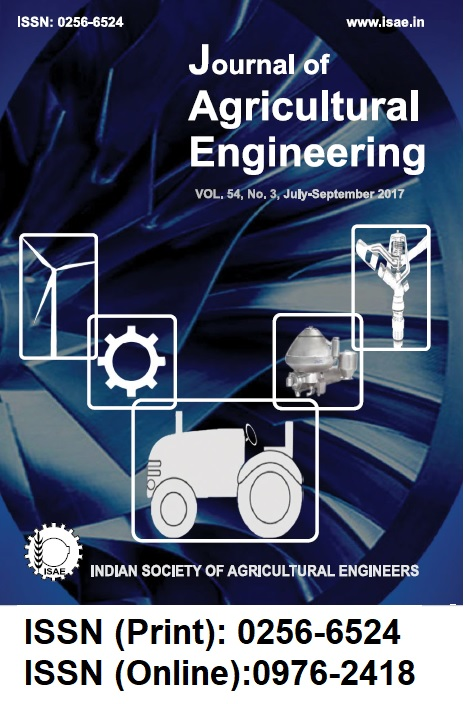Evaluation of Class-A Pan Coefficient Models for Estimation of Reference Crop Evapotranspiration for Dry Sub-humid Climates
DOI:
https://doi.org/10.52151/jae2017543.1633Keywords:
Pan coefficient, class-A pan evaporimeter, reference evapotranspiration, Penman Monteith methodAbstract
Evaporation and evapotranspiration are important parameters for various agricultural activities, which may be estimated using a pan coefficient value obtained from several models. It is a function of wind speed, temperature, relative humidity and fetch length. For dry sub-humid climate of Varanasi, Snyder model was found to be best for estimating the pan coefficient with an average value of 0.79, which closely agreed with pan coefficient value estimated by the standard FAO-56 model. The maximum and minimum average daily pan evaporation for the region was 8.8 mm.day-1 and 2.5 mm.day-1, respectively, in the month of May and December. The reference evapotranspiration estimated using pan coefficient obtained from Snyder method showed lowest MAE of 0.24, RMSE of 0.30, agreement Index of 0.99, percentage error of estimate of 6.51 % and efficiency of 96 per cent. The Mann-Kendall’s non-parametric test used for identifying trend showed an increasing trend for pan coefficient data series, and a decreasing trend for pan evaporation data series at 5 % significance level. Tempoal variation in pan coefficient may be computed for Varanasi meteorological station to estimate reference evapotranspiration.
References
Allen R G; Pereira L S; Raes D; Smith M. 1998. Crop evapotranspiration - guidelines for computing crop water requirements. Irrigation and Drainage Paper No. 56, FAO, Rome, Italy, PP: 300.
Allen R G; Pruitt W O. 1991. FAO-24 Reference evapotranspiration factors. J. Irrig. Drain. Eng., 117 (5), 758-773.
Cuenca R H. 1989. Irrigation System Design: An Engineering Approach. Prentice-Hall. Englewood Cliffs, NJ, USA, pp: 552.
Doorenbos J; Pruitt W O. 1977. Guidelines for prediction of crop water requirements. Irrigation and Drainage Paper No. 24 (revised), FAO, Rome, Italy, pp: 144.
Frevert D K; Hill R W; Braaten B C. 1983. Estimation of FAO evapotranspiration coefficients. J. Irrig. Drain. Eng., 109 (2), 265–270.
George C. 2012. Updating class-A pan coefficients (Kp) for estimating reference evapotranspiration (ET0) in the humid tropical region of Kerala. J. Tropical Agric., 50 (1), 84-87.
Gundekar H G; Khodke U M; Sarkar S; Rai R K. 2008. Evaluation of pan coefficient for reference crop evapotranspiration for semi-arid region. Irrig. Sci., 26 (2), 169-175.
Jhajharia D; Shrivastava S K; Sarkar D; Sarkar S. 2009. Temporal characteristics of pan evaporation trends under the humid conditions of northeast India. Agric. For. Meteorol., 149 (5), 763-770.
Krause P; Boyle D P; Base F. 2005. Comparison of different efficiency criteria for hydrological model assessment. Adv. Geosci., 5, 89–97.
Meshram D T; Gorantiwar S D. 2015. Evaluation of pan coefficient for estimating reference crop evapotranspiration in Solapur station. Maharashtra. Mausam, 66 (2), 205-210.
Nash J E; Sutcliffe J V. 1970. River flow forecasting through conceptual models part I- A discussion of principles. J. Hydrol., 10 (3), 282–290.
Orang M. 1998. Potential accuracy of the popular non-linear regression equations for estimating pan coefficient values in the original and FAO-24 tables. Unpublished Report, California Department of Water Resources, Sacramento, California.
Pdmakumari B; Jaswal A K; Goswami B N. 2013. Decrease in evaporation over the Indian monsoon region: implication on regional hydrological cycle. Clim. Change, 121 (4), 787-799.
Patel C. 2016. Effect of irrigation schedules on wheat crop, it’s evaluation and yield estimation using DSSAT-CERES model. Unpublished Ph. D. thesis, Department of Farm Engineering, Institute Agricultural Sciences, BHU, Varanasi, India.
Pereira A R; Villanova N; Pereira A S; Baebieri V A. 1995. A model for the class-A pan coefficient. Agric. For. Meteorol., 76 (2), 75-82.
Pradhan S; Sehgal V K; Das D K; Bandyopadhyay K K; Singh R. 2013. Evaluation of pan coefficient methods for estimating FAO-56 reference crop evapotranspiration in a semi-arid environment. J. Agrometeorol., 15 (1), 1-4.
Raghuwanshi N S; Wallender W W. 1998. Converting from pan evaporation to evapotranspiration. J. Irrig. Drain. Eng., 124 (5), 275-277.
Rao A V R K; Wani S P. 2011. Evapotranspiration paradox at a semi-arid location in India. J. Agrometeorol., 13 (1), 3-8.
Snyder R L. 1992. Equation for evaporation pan to evapotranspiration conversions. J. Irrig. Drain. Eng., 118 (6), 977–980.
Willmott C J. 1984. On the evaluation of model performance in physical geography. Spatial Stat. Models, 443–460.














